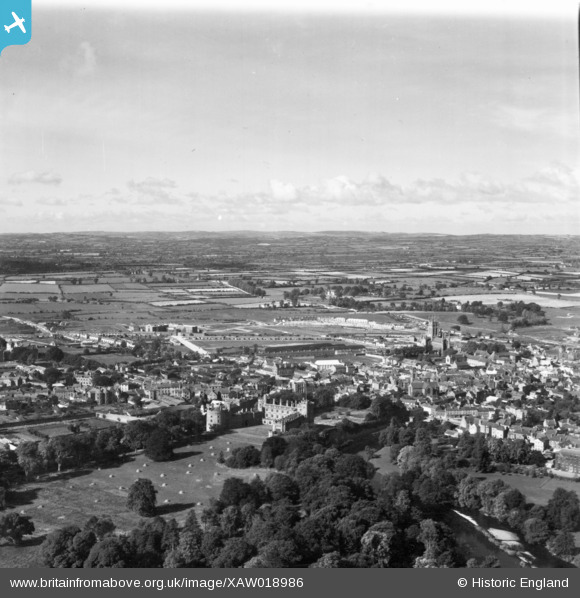XAW018986 IRELAND (1948). General View, Kilkenny, Kilkenny, Ireland, 1948. Oblique aerial photograph taken facing West.
© Copyright OpenStreetMap contributors and licensed by the OpenStreetMap Foundation. 2024. Cartography is licensed as CC BY-SA.
Nearby Images (6)
Details
| Title | [XAW018986] General View, Kilkenny, Kilkenny, Ireland, 1948. Oblique aerial photograph taken facing West. |
| Reference | XAW018986 |
| Date | 21-September-1948 |
| Link | |
| Place name | KILKENNY |
| Parish | IRELAND |
| District | |
| Country | IRELAND |
| Easting / Northing | 44927, 318834 |
| Longitude / Latitude | -7.251828, 52.650633 |
| National Grid Reference |
Pins
 John Byrne |
Saturday 3rd of June 2017 02:55:19 PM | |
 John Swain |
Friday 10th of October 2014 04:18:39 PM | |
 John Swain |
Friday 10th of October 2014 04:16:49 PM | |
 John Swain |
Friday 10th of October 2014 03:55:56 PM | |
 John Swain |
Friday 10th of October 2014 03:55:06 PM | |
 John Swain |
Friday 10th of October 2014 03:52:50 PM | |
 John Swain |
Friday 10th of October 2014 03:51:28 PM | |
 John Swain |
Friday 10th of October 2014 03:47:13 PM | |
 John Swain |
Friday 10th of October 2014 03:42:12 PM | |
 John Swain |
Friday 10th of October 2014 03:41:43 PM |
User Comment Contributions
The historic city of Kilkenny lies on the River Nore, surrounded by fertile farmland and productive limestone (black marble) quarries, between the Castlecomer basin to the NE and the Slieve Ardagh ridge to the W. The settlement has been of significance for more than 1,000 years and has been the major commercial, administrative, industrial and ecclesiastical centre of the county since late medieval times. The 19th century railway builders recognised the importance of the city and the station, on the east side of the river, was opened in 1848, with subsequent links to Dublin, Waterford and Maryborough (Portlaoise). The city's population reached a peak in the early decades of the 19th century at over 20,000, but this figure declined throughout the next hundred years to less than half this total (10,300 in 1946). The urban borough of Kilkenny is only 8,500 at the present time but, including all the surrounding integuments which have grown since the Emergency (1939-45), the population is closer to 24,500. As is evident in these images, Kilkenny has retained much of its inherent medieval charm and is arguably the foremost tourist destination for an inland town of its modest size. This contributor always enjoyed his visits here from 1995. |
 John Swain |
Friday 10th of October 2014 04:36:30 PM |


![[XAW018986] General View, Kilkenny, Kilkenny, Ireland, 1948. Oblique aerial photograph taken facing West.](http://britainfromabove.org.uk/sites/all/libraries/aerofilms-images/public/100x100/XAW/018/XAW018986.jpg)
![[XAW018984] General View, Kilkenny, Kilkenny, Ireland, 1948. Oblique aerial photograph taken facing North/West.](http://britainfromabove.org.uk/sites/all/libraries/aerofilms-images/public/100x100/XAW/018/XAW018984.jpg)
![[XAW027142] General View, Kilkenny, Kilkenny, Ireland, 1949. Oblique aerial photograph taken facing North/East.](http://britainfromabove.org.uk/sites/all/libraries/aerofilms-images/public/100x100/XAW/027/XAW027142.jpg)
![[XAW027140] General View, Kilkenny, Kilkenny, Ireland, 1949. Oblique aerial photograph taken facing East.](http://britainfromabove.org.uk/sites/all/libraries/aerofilms-images/public/100x100/XAW/027/XAW027140.jpg)
![[XAW018985] General View, Kilkenny, Kilkenny, Ireland, 1948. Oblique aerial photograph taken facing West.](http://britainfromabove.org.uk/sites/all/libraries/aerofilms-images/public/100x100/XAW/018/XAW018985.jpg)
![[XAW027143] General View, Kilkenny, Kilkenny, Ireland, 1949. Oblique aerial photograph taken facing North/East.](http://britainfromabove.org.uk/sites/all/libraries/aerofilms-images/public/100x100/XAW/027/XAW027143.jpg)




